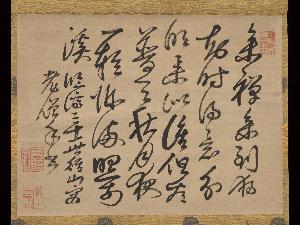Feiyin Tongrong
Feiyin Tongrong;Hiin Tsūyō
Place: China
Born: 1593
Death: 1661
Biography:
Feiyin Tongrong, also known as Hiin Tsūyō, was a Chinese Buddhist monk who studied under several renowned Chan (Japanese: Zen) masters, served as the abbot of several monasteries, and was a prolific writer and calligrapher. He was a central figure in the Ōbaku Zen school, which was brought to Japan by his teacher, Yinyuan Longqi (Ingen Ryūki).
Early Life and Career
Feiyin Tongrong was born in 1593 in China and entered the monastic life at a young age. He studied under several prominent Zen masters, including Miyun Yuanwu, and became known for his exceptional calligraphic skills and poetic phrases. His calligraphic style was characterized by strong, boldly brushed characters in one or sometimes two columns.
Artistic Contributions
Feiyin Tongrong's artistic contributions are highly regarded, particularly in the realm of Zen art. His paintings, such as Couplet of Chinese Verse on Spiritual Enlightenment, showcase his mastery of cursive script and convey profound Buddhist teachings. The Metropolitan Museum of Art features some of his notable works, including a poem inscribed in cursive script that conveys his wish to impart his teachings.
Influence and Legacy
Feiyin Tongrong's influence on Zen art and Buddhism is significant. He advocated for a reassessment of Chan practice and its transmission through history, asserting the superiority of the Linji (Rinzai) sect over that of the Caodong (Sōtō). His disciples traveled to Japan, where they established Manpukuji Temple as the center for promoting his ideas. Key aspects of Feiyin Tongrong's biography include:
- His exceptional calligraphic skills and poetic phrases
- His role in the Ōbaku Zen school and its introduction to Japan
- His advocacy for a reassessment of Chan practice and its transmission through history
Feiyin Tongrong's legacy can be explored further by visiting Wikioo.org, which features his artworks, including Couplet of Chinese Verse on Spiritual Enlightenment. The Metropolitan Museum of Art and Wikioo.org also provide valuable insights into his life and artistic contributions.


